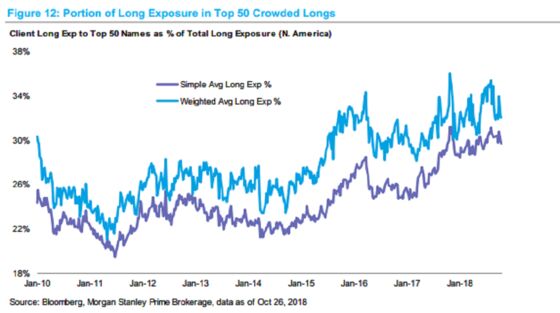For Crowded Stocks at Heart of Sell-Off, Few Signs of Unwinding
The idea that crowded trades exacerbate routs has been a popular one of late but its logic isn’t universally accepted.
(Bloomberg) -- The worst month for stocks in seven years just ended with the biggest rally since February. Did the forces that snarled equities recede? Going by data on popular positions, it may be a little early to sound the all-clear.
“Crowded trades” has become a catchphrase of the rout, denoting declines in stocks beloved by professional investors that were two or three times worse than the rest of the market. And while the $2 trillion sell-off has eased some of the congestion, it has yet to spur a wholesale unwinding.
“Maybe we’ve had a modest rest, but the extent to which investors are jumping back into some of the most crowded names tells me that we are far from some sort of capitulation,” said Gina Martin Adams, chief equity strategist at Bloomberg Intelligence. “I am amazed at how everyone is trying to get back into the FANGs again, with the exclusion of Facebook.”
Real-time information on this phenomenon is scarce, but going by data from Morgan Stanley’s brokerage unit for institutions, crowdedness has yet to ease back to its historic average. As of last Friday, the 50 most popular stocks made up 32 percent of long positions among hedge fund clients. While that’s down from a peak of 35 percent in August, it’s still above 87 percent of readings since the bank began tracking the data in 2010.

To measure a similar risk, RBC Capital Markets looks at positioning in U.S. equity futures, which it says reached extremes in early October consistent with the period before the financial crisis. While easing has occurred, the indicator is still well above levels of past years.
“We don’t think we’re out of the woods yet,” Lori Calvasina, head of U.S. equity strategy at RBC, said in a note Monday. She urged investors to continue to shun technology and communication services, industries with the highest concentration of long-only owners.
The idea that crowded trades exacerbate routs has been a popular one of late but its logic isn’t universally accepted. After all, every share that is sold is bought by someone else, and a case can be made that outsize ownership by hedge funds signals a company is doing something right.
A refusal to abandon past winners may just show that institutions don’t believe the sell-off was justified.
“That hedge funds didn’t take their exposure down says to me that they believe in their core positions,” Benjamin Dunn, president of the portfolio-consulting practice at Alpha Theory, said by phone. “There has been very little fundamental news out of this reason to sway most of the investors that I speak to from their thesis in any direction.”
Investors looking to explain October’s volatility have a lot of choices, everything from tightening financial conditions, trade angst and lackluster earnings. But the one force that comes closest to tying it together is concentration. Stocks that biggest investors love got demolished.
It’s not just the FANG complex of internet darlings. If you rank stock performance by hedge fund ownership, a near-perfect correlation arises in October, with the most heavily owned shares dropping the most. Among companies in the Russell 1000 Index, the 200 most popular ones have seen their shares lose twice as much as the bottom quintile, data compiled by Bloomberg showed.

That too much money was chasing the same stocks is something bears have been warning about for years. On Monday, the top 10 most popular stocks among hedge funds trailed the S&P 500 by almost 3 percentage points. That was the worst day in the history of Morgan Stanley’s primary brokerage unit.
Consider the FANG block of Facebook Inc., Google parent Alphabet Inc., Amazon.com Inc. and Netflix Inc. While their 14 percent drop in October was the most on record, it pales in comparison to their outsize gains over a longer time frame. The group has surged at an annualized pace of 41 percent in the past five years, almost four times the gain in the S&P 500.
“Earlier this year, when people were piling into trades and the earnings multiple is crazy and yet you see people buying it,” said Kim Forrest, senior portfolio manager at Fort Pitt Capital. “It works the other way, too. When something’s selling off, sometimes people will sell it for no fundamental reason other than that everyone else has sold it and they can’t bear the pain.”
--With assistance from Melissa Karsh and Elena Popina.
To contact the reporters on this story: Lu Wang in New York at lwang8@bloomberg.net;Vildana Hajric in New York at vhajric1@bloomberg.net
To contact the editors responsible for this story: Courtney Dentch at cdentch1@bloomberg.net, Chris Nagi, Eric J. Weiner
©2018 Bloomberg L.P.